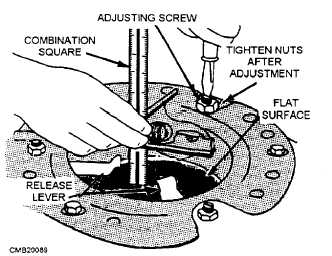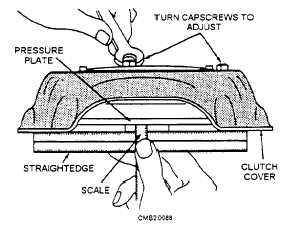The last area to check before reassembly is the clutch fork. If it is bent or worn, the fork can prevent the clutch from releasing properly. Inspect both ends of the fork closely. Also, inspect the clutch fork pivot point in the clutch housing; the pivot ball or bracket should be undamaged and tight.
When a new pressure plate is installed, do not forget to check the plate for proper adjustments. These adjustments will ensure proper operation of the pressure plate. The first adjustment ensures proper movement of the pressure plate in relation to the cover. With the use of a straightedge and a scale as shown in figure 4-11, begin turning the adjusting screws until you obtain the proper clearance between the straight-edge and the plate as shown. For exact measurements, refer to the manufacturer's service manual.
The second adjustment positions the release levers and allows the release bearing to contact the levers simultaneously while maintaining adequate clearance of the levers and disc or pressure plate cover. This adjustment is known as finger height. To adjust the pressure plate, place the assembly on a flat surface and measure the height of the levers, as shown in figure 4-12. Adjust it by loosening the locknut and turning. After the proper height has been set, make sure the locknuts are locked and staked with a punch to keep them from coming loose during operations. Exact release lever height can be found in the manufacturer's service manual.
Reassemble the clutch in the reverse order of disassembly. Mount the clutch disc and pressure plate on the flywheel. Make sure the disc is facing in the right direction. Usually, the disc's offset center (hub and torsion springs) fit into the pressure plate.

Figure 4-12. - Pressure plate release lever adjustment.
If reinstalling, the old pressure plate lines up the alignment marks made before disassembly. Start all of the pressure plates bolts by hand. Never replace a clutch pressure plate bolt with a weaker bolt. Always install the special case-hardened bolt recommended by the manufacturer.
Use a clutch alignment tool to center the clutch disc on the flywheel. If an alignment tool is unavailable, an old clutch shaft from the same type of vehicle may be used. Tighten each pressure plate bolt a little at a time in a crisscross pattern. This will apply equal pressure on each bolt, as the pressure plate spring(s) are compressed. When the bolts are snugly in place, torque them to the manufacturer's specifications found in the service manual. Once the pressure plates bolts are torqued to specs, slide out the alignment tool. Without the clutch disc being centered, it is almost impossible to install the transmission or transaxle.
Next install the clutch fork and release bearing in the clutch housing. Fit the clutch housing over the rear of the engine. Dowels are provided to align the housing on the engine. Install and tighten the bolts in a crisscross manner.
Install the transmission and drive shaft or the transaxle and axle shafts. Reconnect the linkages, the cables, any wiring, the battery, and any other parts required for disassembly. After all parts have been installed, adjust the clutch pedal free travel as prescribed by the manufacturer and test-drive the vehicle for proper operation.

Figure 4-11. - Pressure plate adjustment.
REVIEW 1 QUESTIONS
Q1. What is the function of the automotive clutch?
Continue Reading